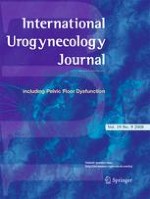Published in:

01-09-2008 | Original Article
Resolution of elevated postvoid residual volumes after correction of severe pelvic organ prolapse
Authors:
Ching-Chung Liang, Ling-Hong Tseng, Shuenn-Dhy Chang, Yao-Lung Chang, Tsia-Shu Lo
Published in:
International Urogynecology Journal
|
Issue 9/2008
Login to get access
Abstract
We hypothesized that elevated postvoid residual volume (PVRV) would resolve postoperatively in women with severe pelvic organ prolapse (POP) and investigated risk factors that might hamper its resolution. Retrospectively, we enrolled 57 patients undergoing surgery for severe POP. All patients had preoperative PVRV ≥ 100 ml documented by ultrasound and catheterization. Presurgical voiding difficulty, urodynamic and cystoscopic data, and surgical outcome were analyzed. The incidence of postsurgical elevated PVRV was 15.8% and 3.5% was symptomatic. Patients with postsurgical elevated PVRV had larger preoperative residual volume than those with normal postsurgical PVRV (P = 0.037). By multivariable analysis, concomitant anti-incontinence surgery was the single independent predictor of postsurgical elevated PVRV (odds ratio = 5.38, P = 0.031). A majority of patients with severe POP had their elevated PVRV resolved postoperatively. Although concomitant anti-incontinence surgery increased the risk of developing elevated PVRV after repair, most remained asymptomatic.